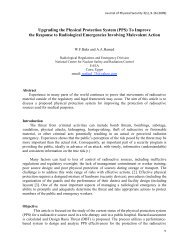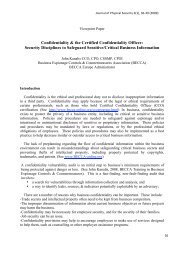<strong>The</strong> <strong>Journal</strong> <strong>of</strong> <strong>Physical</strong> <strong>Security</strong> 4(2), i‐viii (2010)3. <strong>The</strong>re is considerable enthusiasm for, great pride in, and strong emotion behind the proposed(or fielded) technology or procedure.4. <strong>The</strong> technology or procedure is a pet technology <strong>of</strong> the promoters and developers, notnecessarily the technology or procedure that was chosen from among many candidates as a result<strong>of</strong> a careful study <strong>of</strong> the specific security/safeguards/verification problem <strong>of</strong> interest.5. <strong>The</strong> security/safeguards/verification technology or procedure is viewed with great confidence,arrogance, and/or represented as “impossible defeat” or nearly so. (Effective security is verydifficult to achieve. Generally, if promoters and developers <strong>of</strong> a given security or safeguardsapproach or hardware have carefully considered the real-world security issues, they will not be insuch a boosterism mode. Fear is, in fact, a good indicator <strong>of</strong> a realistic mindset when it comes tosecurity.)6. <strong>The</strong>re is a great deal <strong>of</strong> bureaucratic or political inertia behind the technology or procedure.7. Substantial time, funding, and political capital has already been spent developing, promoting,or analyzing the technology or procedure.8. <strong>The</strong> people or organization promoting the technology or procedure have a conflict <strong>of</strong> interest,or at least are unable to objectively evaluate it.9. No vulnerability assessors, people with a “hacking” mentality, devil’s advocates, or creativequestion-askers have closely examined the technology or procedure (perhaps because theyweren’t allowed to).10. Anybody questioning the efficacy <strong>of</strong> the technology or procedure is ignored, attacked,ostracized, or retaliated against.11. <strong>The</strong> people developing or promoting the technology or procedure have no real-worldsecurity experience.12. <strong>The</strong> people developing or promoting the technology or procedure are mostly engineers. (Noinsult to engineers intended here. In our experience, the mindset and practices that makes onegood at engineering aren’t the optimal mindset for good security. Engineers tend to work insolution space, not problem space. <strong>The</strong>y tend to view Nature and stochastic failures as theadversary, not maliciously evil people who attack intelligently and surreptitiously. <strong>The</strong>y strive todesign devices, hardware, and s<strong>of</strong>tware that are user friendly, easy to service, and full <strong>of</strong> optionalfeatures—which tends to make attacks easier.)13. Vulnerabilities are only considered, and vulnerability assessors only involved, after thedevelopment <strong>of</strong> the technology or procedure has been nearly completed. (At this point, it isusually too difficult to make necessary changes to improve the security for economic, political,timeliness, or psychological reasons).14. <strong>The</strong> technology or procedure involves new technology piled on existing technology orvi
<strong>The</strong> <strong>Journal</strong> <strong>of</strong> <strong>Physical</strong> <strong>Security</strong> 4(2), i‐viii (2010)procedures in hopes <strong>of</strong> getting better security, but without actually addressing the Achilles heel<strong>of</strong> the old technology or procedure.15. <strong>The</strong> technology or procedure relies primarily on complexity, advanced technology, the latesttechnological “fad”, and/or multiple layers. (High technology does not equal high security, andlayered security isn’t always better.)16. Any consideration <strong>of</strong> security issues focuses mostly on s<strong>of</strong>tware or firmware attacks, not onphysical security.17. <strong>The</strong> main tamper detection mechanism—if there even is one—is a mechanical tamper switchor an adhesive label seal. (This is approximately the same, in our experience, as having notamper detection at all.)18. <strong>The</strong> technology or procedure is not directed against a specific, well-defined adversary withwell-defined resources.19. <strong>The</strong> end users <strong>of</strong> the technology or procedure have never been consulted and/or thetechnology or procedure is being forced on them from above. (<strong>The</strong>se are people who understandthe real-world implementation issues, and are the ones who will have to make the technology orprocedure actually work).20. <strong>The</strong> technology or procedure is not well understood by the non-technical people proposingor promoting it (or by the people in the field who are to use it), and/or the terminology beingused is misleading, confusing, or ambiguous.21. Particularly with security procedures: control or formalism gets confused with security.22. Domestic and international nuclear safeguards get confused. (<strong>The</strong>se two securityapplications are remarkably dissimilar.)23. <strong>The</strong> technology or procedure in question makes people feel good. (In general, real securitydoesn’t make people feel better, it makes them feel worse. This is because it is almost alwaysmore expensive, time-consuming, and painful than <strong>Security</strong> <strong>The</strong>ater. When security orsafeguards are thoroughly thought-through, the difficulty <strong>of</strong> the task and knowledge <strong>of</strong> theunmitigated vulnerabilities will cause alarm. Fear is a good vaccine against both arrogance andignorance.This is the basis <strong>of</strong> what we call the “Be Afraid, Be Very Afraid Maxim”: If you’re notrunning scared, you have bad security or a bad security product.)24. <strong>The</strong> use protocols for the technology or procedures are non-existent, vague, or ill-conceived.25. <strong>The</strong> security application is exceeding difficult, and total security may not even be possible.26. <strong>The</strong> terminology is vague, confusing, misleading, or full <strong>of</strong> wishful thinking, e.g., “highsecurity”, “tamper-pro<strong>of</strong>”, “pick pro<strong>of</strong>”, “undefeatable”, “due diligence”, “barrier”, “certified”,vii
- Page 2 and 3: Table of ContentsJournal of Physica
- Page 4 and 5: The Journal of Physical Security 4(
- Page 6 and 7: The Journal of Physical Security 4(
- Page 10 and 11: The Journal of Physical Security 4(
- Page 12 and 13: Journal of Physical Security 4(2),
- Page 14 and 15: Journal of Physical Security 4(2),
- Page 16 and 17: Journal of Physical Security 4(2),
- Page 18 and 19: Journal of Physical Security 4(2),
- Page 20 and 21: Journal of Physical Security 4(2),
- Page 22 and 23: Journal of Physical Security 4(2),
- Page 24 and 25: Journal of Physical Security 4(2),
- Page 26 and 27: Journal of Physical Security 4(2),
- Page 28 and 29: Journal of Physical Security 4(2),
- Page 30 and 31: Journal of Physical Security 4(2),
- Page 33 and 34: Journal of Physical Security 4(2),
- Page 35 and 36: Journal of Physical Security 4(2),
- Page 37 and 38: Journal of Physical Security 4(2),
- Page 39 and 40: Journal of Physical Security 4(2),
- Page 41 and 42: Journal of Physical Security 4(2),
- Page 43 and 44: Journal of Physical Security 4(2),
- Page 45 and 46: Journal of Physical Security 4(2),
- Page 47 and 48: Journal of Physical Security 4(2),
- Page 49 and 50: Journal of Physical Security 4(2),
- Page 51 and 52: Journal of Physical Security 4(2),
- Page 53 and 54: Journal of Physical Security 4(2),
- Page 55 and 56: Journal of Physical Security 4(2),
- Page 57: Journal of Physical Security 4(2),





